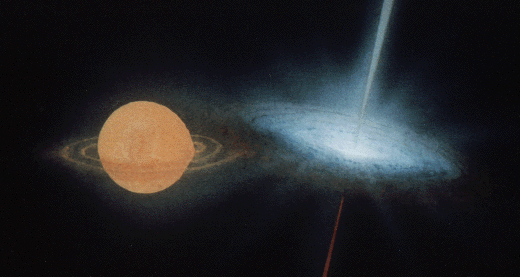Astronomy Picture of the Day
Discover the cosmos!
Each day a different image or photograph of our fascinating universe is
featured, along with a brief explanation written by a professional
astronomer.
March 6, 1996

Jets From SS433
Credit:
NASA
Artist's Visualization
Explanation:
SS433 is one of the most exotic star systems known to astronomers.
Its unremarkable name stems from its inclusion in a catalogue of
stars which emit radiation characteristic of
atomic hydrogen.
Its very remarkable behavior stems from a compact
object, a
black hole or
neutron star, which has produced an
accretion disk with jets.
As illustrated in this
artist's vision of
the SS433 system based on
observational data,
a massive, hot star (left) is locked in
a mutual orbit with a compact object. Material transfers from the
massive star into
an accretion disk surrounding the
compact object
blasting out two jets of ionized gas in opposite directions -
at about 1/4 the speed of light! Radiation from the jet tilted toward
the observer is blueshifted, while radiation from the jet tilted away
is redshifted.
The binary system itself completes an orbit in about 13 days while the jets
precess (wobble like a top) with a period of about 164 days.
Are the jets from SS433 related to those from
black holes at the centres of galaxies
Tomorrow's picture: Rampaging Fronts of the Veil Nebula
<
Archive
| Index
| Search
| Calendar
| Glossary
| Education
| About APOD
>
Authors & editors:
Robert Nemiroff
(MTU) &
Jerry
Bonnell (USRA)
NASA Technical Rep.:
Jay Norris.
Specific rights apply.
A service of:
LHEA
at
NASA/
GSFC
&:
Michigan Tech. U.
